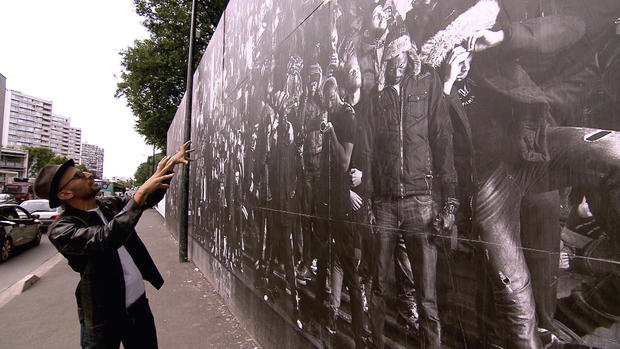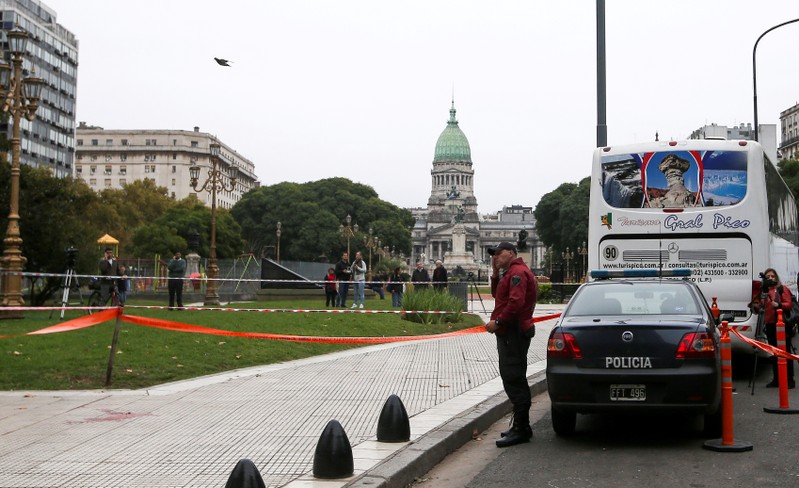Every once in a while, an artist creates work so bold that it makes the world—and 60 Minutes—stop and take notice.
Just as their mediums differ, the artists 60 Minutes has profiled also have varying perspectives on what their work means. Some artists believe art should be nothing more than a thing of beauty. For others, being an artist means being an activist.
This week, correspondent Anderson Cooper turns the spotlight on a new visual master in the art world: Mark Bradford, an abstract artist whose work often deals with complex social issues. His piece “Deep Blue,” now on display at Los Angeles’s Broad Museum, makes a 50-foot-long statement about the race riots in Los Angeles’s Watts neighborhood in 1965.
“I’m grappling with how I feel about that subject and that material,” Bradford tells Cooper on the broadcast. “I do grapple with things. I grapple with things personally, and racially, and politically. What does it mean to be me?”
Here’s a look back at some of the other artists whose work 60 Minutes has featured.
Chinese activist Ai Weiwei
Like Bradford, Chinese dissident Ai Weiwei thinks art should make a statement.
“I think every art, if it’s relevant, is political,” Ai told Holly Williams when she interviewed him for 60 Minutes in 2017.
As Williams reported, Ai is one of the most successful contemporary artists in the world. He’s a designer, sculptor, photographer and blogger who has earned fans by using his art to ridicule authorities and make social statements. Turning his focus to the plight of refugees in recent years, Ai made an installation from the discarded clothes and shoes left by those fleeing to Europe. He filled a pond at a museum in Vienna with migrants’ life jackets.
But in China, Ai’s art has gotten him harassed by police, thrown in detention, and even driven out of the country.
“I think artist and activist is the same thing,” Ai said. “As artist, you always have to be an activist.”
French photographer JR
French photographer JR may not be immediately recognizable, either in image or name, but his giant photographs probably are—they’ve appeared in some 140 countries around the world. Like Ai and Bradford, JR wants his art to make a statement with his oversized photographs of everyday people.
What does he hope to say? “They exist,” he told Anderson Cooper.
The faces JR photographs have been pasted on rooftops in a Nairobi slum, on buildings in Istanbul, on New York City sidewalks, and in a Tunisian police station looted during the Arab Spring. On the wall separating Israel and Palestinian territory, he pasted images of Israelis and Palestinians side-by-side.
JR often photographs people who would otherwise be overlooked or people whose status makes them outsiders in society. He told Cooper he wants people to see the humanity within his photograph’s subjects.
“When you look at those face, it makes you want to smile,” he said. “By playing the monster, they don’t look like monster anymore.”
Christo and Jeanne-Claude
For husband and wife team Christo and Jeanne-Claude, art is nothing more than a striking thing to see. So when they put some 7,500 gates in New York City’s Central Park, each suspending a saffron-colored flag, they didn’t do it to make a statement.
“It’s only ‘The Gates,’ a work of art of joy and beauty,” Jeanne-Claude told correspondent Morley Safer in 2005. “We do not build messages. We do not build symbols. It’s only a work of art, nothing else.”
Even though the couple didn’t have a message, they often had to struggle to create their art. In Germany, they fought six successive presidents for permission to wrap the Reichstag in metallic fabric. In France, they battled Jacques Chirac for 10 years before he eventually allowed them to wrap the Pont Neuf, Paris’s oldest bridge, in silky golden fabric. At one point, the pair installed 3,000 giant umbrellas outside Los Angeles and Tokyo simultaneously.
“The Christos are an obsessive, two-headed force of nature,” Safer reported.
Jeanne-Claude died in 2009.





